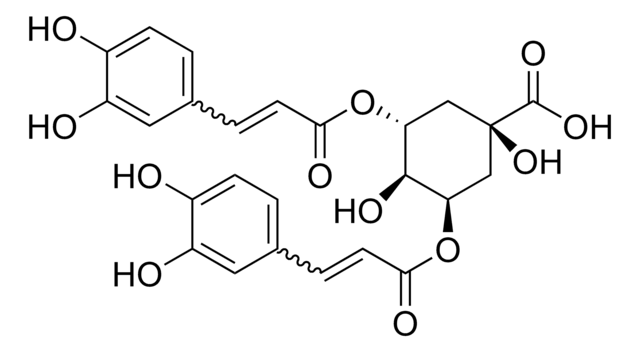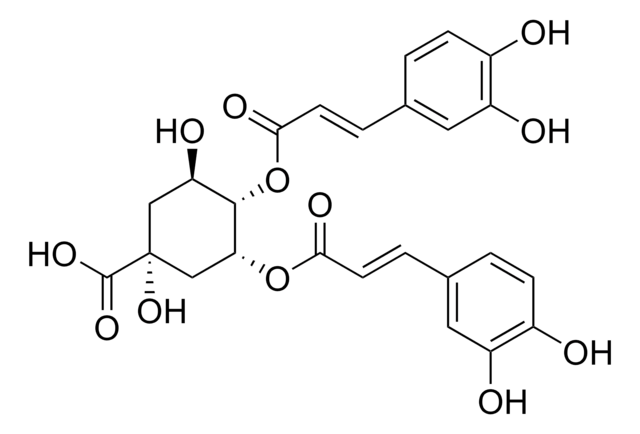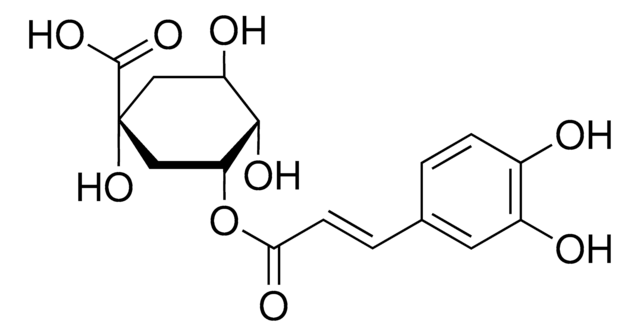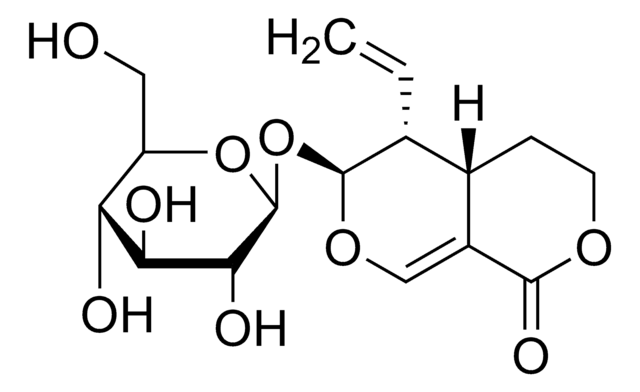SMB00224
3,4-Di-O-caffeoylquinic acid
≥90% (LC/MS-ELSD)
Synonym(e):
3,4-DICQA, 3,4-Di-O-caffeoylquinate, 3,4-Dicaffeoylquinic acid, Isochlorogenate B, Isochlorogenic acid B
About This Item
Empfohlene Produkte
Assay
≥90% (LC/MS-ELSD)
Form
solid
Anwendung(en)
metabolomics
vitamins, nutraceuticals, and natural products
Lagertemp.
−20°C
SMILES String
O[C@@H]1C[C@](O)(C[C@@H](OC(=O)\C=C\c2ccc(O)c(O)c2)[C@@H]1OC(=O)\C=C\c3ccc(O)c(O)c3)C(O)=O
InChI
1S/C25H24O12/c26-15-5-1-13(9-17(15)28)3-7-21(31)36-20-12-25(35,24(33)34)11-19(30)23(20)37-22(32)8-4-14-2-6-16(27)18(29)10-14/h1-10,19-20,23,26-30,35H,11-12H2,(H,33,34)/b7-3+,8-4+/t19-,20-,23-,25+/m1/s1
InChIKey
UFCLZKMFXSILNL-PSEXTPKNSA-N
Suchen Sie nach ähnlichen Produkten? Aufrufen Leitfaden zum Produktvergleich
Verwandte Kategorien
Allgemeine Beschreibung
Anwendung
- to quantify the caffeoylquinic acids of Artemisia frigida Willd. (Fringed sagewort) using high-performance liquid chromatography with diode array detection and electrospray ionization triple quadrupole mass spectrometric detection (HPLC-DAD-ESI-QQQ-MS)
- to quantify the phenolic compounds of Artemisia species using high-performance liquid chromatography with diode array detection (HPLC-DAD) technique
- for metabolic profiling of methanolic leaf extract of A. nallamalayana and to identify the phenolic acids using High-Performance Liquid Chromatography-Ultraviolet (HPLC-UV) analysis
Biochem./physiol. Wirkung
Lagerklassenschlüssel
11 - Combustible Solids
WGK
WGK 3
Flammpunkt (°F)
Not applicable
Flammpunkt (°C)
Not applicable
Analysenzertifikate (COA)
Suchen Sie nach Analysenzertifikate (COA), indem Sie die Lot-/Chargennummer des Produkts eingeben. Lot- und Chargennummern sind auf dem Produktetikett hinter den Wörtern ‘Lot’ oder ‘Batch’ (Lot oder Charge) zu finden.
Besitzen Sie dieses Produkt bereits?
In der Dokumentenbibliothek finden Sie die Dokumentation zu den Produkten, die Sie kürzlich erworben haben.
Kunden haben sich ebenfalls angesehen
Unser Team von Wissenschaftlern verfügt über Erfahrung in allen Forschungsbereichen einschließlich Life Science, Materialwissenschaften, chemischer Synthese, Chromatographie, Analytik und vielen mehr..
Setzen Sie sich mit dem technischen Dienst in Verbindung.







